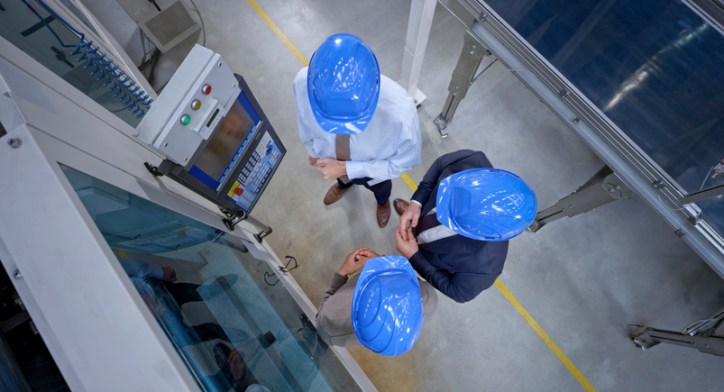Machines might not make the world go round, but they definitely help us out on its surface. Unfortunately—even before pulley systems supported the construction of megaliths in Ancient Egypt—machines have had inherent risks. In fact, there were 14,625 occupational fatalities involving machinery from 1992 to 2010.
Safeguarding machinery is essential, so the ANSI B11 series of American National Standards provides engineers, manufacturers, and personnel with the safety of machinery.
What is a Machine?
As defined in ANSI B11.0-2020: Safety Of Machinery, a machine is:
“An assembly of linked parts or components (at least one of which moves) with the appropriate actuators, control and power circuits, etc., that are joined together for a specific application such as, for the processing, treatment, marking, or moving of material.”
How ANSI B11 Standards Addresses Machinery Risks
This definition encompasses a vast range. Therefore, the ANSI B11 standards address a multitude of workplace machinery with the goal of minimizing the risks of potential machinery-related hazards. This is accomplished through appropriate machine design, restricting personnel access to hazard zones, and devising procedures that minimize personnel exposure to hazardous situations.
Zero risk does not exist. With this in mind, since the first B11 standard was approved with safety requirements for power presses in 1922, these standards, administered by the ANSI-accredited standards developing organization B11 Standards, Inc, have helped professionals reach an acceptable level of machinery-related risk.
ISO Type ABC Machinery
Essential to understanding the ANSI B11 standards is the ISO type A-B-C structure established in ANSI/ISO 12100:2012 (if you’d like to learn the difference between this and the safety of machinery American National Standard, please refer to our post ANSI B11.0-2020: Safety of Machinery). These types delineate machinery safety standards into the following:
Type A standards are basic safety standards, meaning they give concepts, design principles, and general aspects applicable to machinery.
Type B standards are considered generic safety standards, as they deal with one aspect of safety or one safeguard applicable across a range of machinery.
Type C standards are machine safety standards, and they, taking a narrower focus, detail safety guidelines for a particular machine or group of machinery.
You can learn more about these classifications in out post on the ISO Type A-B-C Structure.
All ANSI B11 Standards
In total, there are 26 ANSI B11 standards (please note that ANSI B11.14 was withdrawn, and its requirements are now contained in part 18), and 6 technical reports (which are not American National Standards). All these documents are listed below.
Type A Standards (Basic Machine Safety)
ANSI B11.0-2020: Safety Of Machinery (learn more in our post on the standard)
Type C Standards (Machine Safety)
ANSI B11.1-2009 (R2020): Safety Requirements For Mechanical Power Presses
ANSI B11.2-2013 (R2020): Safety Requirements For Hydraulic And Pneumatic Presses
ANSI B11.3-2022: Safety Requirements For Power Press Brakes
ANSI B11.4-2003 (R2020): Safety Requirements For Shears
ANSI B11.5-1988 (R2020): Machines – Ironworkers -Safety Requirements For Construction, Care And Use
ANSI B11.6-2022: Safety Requirements For Manual Turning Machines With Or Without Auto Control
ANSI B11.7-2020: Cold Headers And Cold Formers – Safety Requirements For Construction, Care, And Use
ANSI B11.9-2010 (R2020): Safety Requirements For Grinding Machines
ANSI B11.10-2003 (R2020): Safety Requirements For Metal Sawing Machines
ANSI B11.11-2001 (R2012): Safety Requirements For Gear And Spline Cutting Machines
ANSI B11.12-2005 (R2020): Safety Requirements For Roll Forming & Roll Bending Machines
ANSI B11.15-2022: Safety Requirements For Pipe, Tube And Shape Bending Machines
ANSI B11.17-2023: Safety Requirements For Horizontal Hydraulic Extrusion Presses
ANSI B11.24-2002 (R2020): Safety Requirements For Transfer Machines
ANSI B11.27-2024: Safety Requirements For Electrical Discharge Machines
Type B Standards (Generic Safety)
ANSI B11.19-2019: Performance Requirements For Risk Reduction Measures: Safeguarding And Other Means Of Reducing Risk (learn more in our post on the standard)
ANSI B11.20-2017: Safety Requirements For Integrated Manufacturing Systems (learn more in our post on the standard)
ANSI B11.25-2022: Safety Requirements For Large Machines
B11.TR1-2016: Ergonomic Guidelines For The Design, Installation And Use Of Machine Tools
B11.TR4-2004: Selection Of Programmable Electronic Systems (PES/PLC) For Machine Tools
Buy All ANSI B11 Standards and Technical Reports at a Discount
All these documents are available together as the ANSI B11 Machine Tools Safety Package—an impressive and useful collection for users of this series of standards, as it comes with over a 50% discount.
